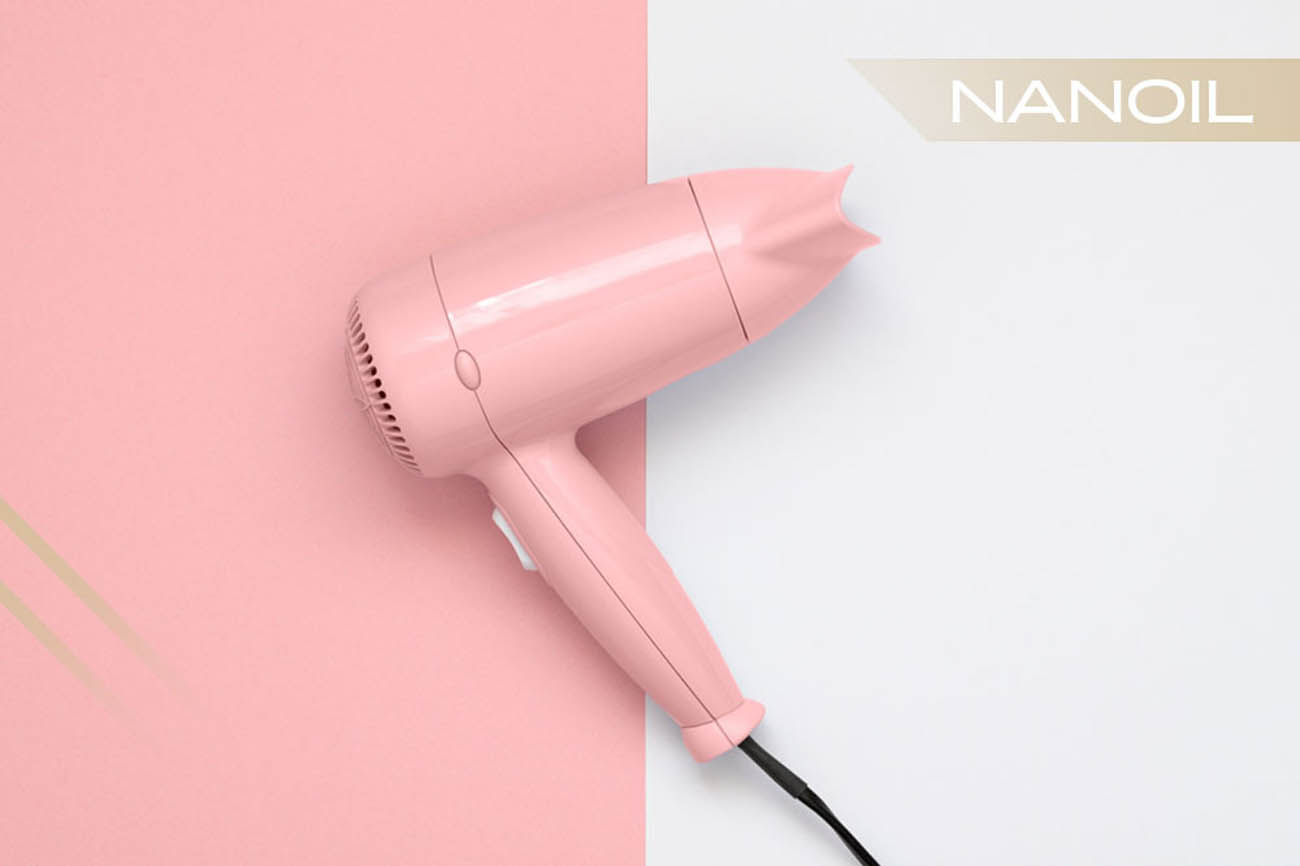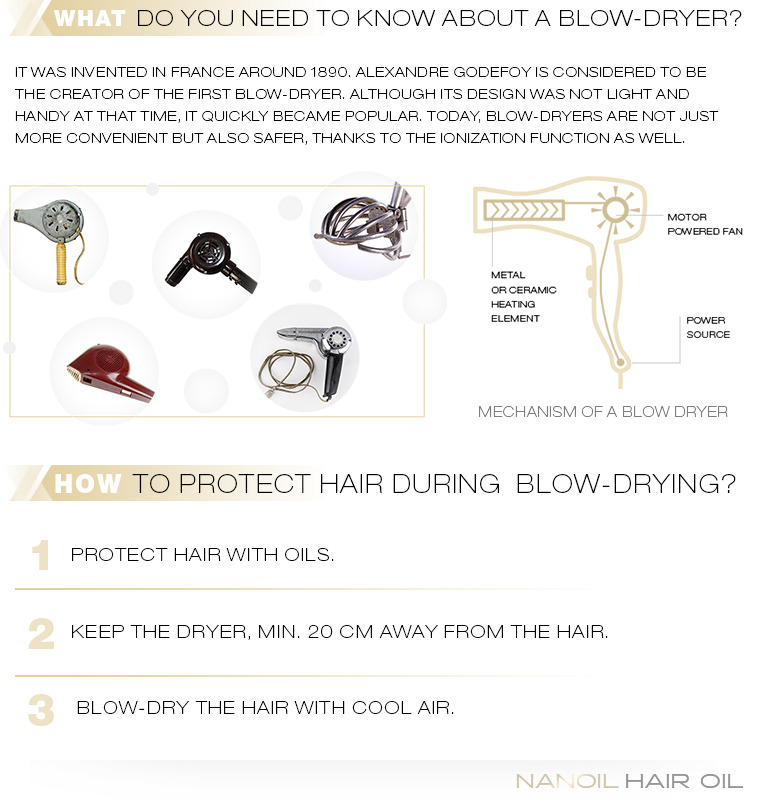- NANOIL Products
- Oils
- Face serums
- Hair masks
- Shampoos
- Hair conditioners
- Hair styling
- Hair Porosity Test
- Blog
- Contact

You’ve overslept but… you must wash your hair? In spite of the notoriety of a blow-dryer, we tend to use it in crisis. Check if regular blow-drying is really such a bad idea. Does a blow-dryer cause hair damage? How does it work?
It won’t be a lie if we say that there’s a hair dryer in almost every house. It is a tool which makes hair easier to work with, lets you style the desired hairdo and most of all it allows for drying the strands in a few mins. You must know that a blow-dryer is a relatively new invention. In the past, the hair was air or wind-dried.

When was a hair blow-dryer invented? It is hard to give an exact date because there were different prototypes of today’s dryers. The first device, which resembled modern blow-dryers, is said to be made in France in 1890.
Giving the name of a blow-dryer’s creator is much easier. We should send our thanks to a Parisian hairdresser. There’s a saying that the necessity is the mother of invention. It’s true in this case. Alexandre Godefoy constructed the first dryer as he wanted to reduce the hairstyling routine time. Both clients and hairdressers benefited from such a solution. Sadly, Godefoy’s tool wasn’t flawless: it was massive and heavy, not making the drying routine much easier.
1899 was the year of a breakthrough. While speaking of the blow-dryer’s inventors, we must mention Mikhail Dolivo-Dobrovolsky – an engineer who worked in German AEG factories. He made the first efficient blow-dryer and gave it a truly romantic name - Fön (a warm mountain wind).
Attempts to make a lighter and comfier device were more and more common. An electric broom (Pneumatic Cleaner) was one of the inspirations – advertised by a woman who blow-dried her hair instead of vacuuming! Consequently, a Race blow-dryer was made in vacuum-cleaner factories at the beginning of the 20th century.
With the passing time, hair dryers were improved to reduce the weight (first ones weighed even two pounds!), prevent overheating and facilitate the blow-dry routine. The design was upgraded, the new functions were added so modern blow-dryers are completely different.
Since we already know when the first blow-dryer was made and learnt a bit of its history, it’s high time to check how it actually works. Contrary to appearances, it’s simple. Inside of every dryer, there is a heating element and a ventilator which directs the air and forces the heat out.
There are different types of hair blow-dryers. The basic category considers the material that the heating element is made of. There are:
A metal wire used to work as a heating element. It was too dangerous, though. Hair could get tangled and burnt. Modern dryers are much safer and have ceramic heating elements in most cases. Their quality is very high and you would have to work a lot to get your hair burnt.
Fun fact! Is it true you can get an electric shock after throwing a running blow-dryer into a bathtub filled with water? It was likely in the past (hence all the movie scenes). Today, blow-dryers come with systems that prevent such situations. You aren’t going to kill anyone with a modern dryer.
It is among the most common questions connected with blow-dryers. As always in case of such doubts, there is no straightforward answer. A blow-dryer leaves your hair damaged if you use it the wrong way. Still, this tool is extremely useful.
A blow-dryer may cause hair damage only if:
Key info: damaged hair is much more sensitive to the action of a blow-dryer.
The key thing is that a fine-quality hair dryer, used according to instructions, helps you take your hair under control – define the curl, add volume or make it straight! For example, blow-drying with a cool airflow closes cuticle scales for silky smooth and shiny hair. A dryer won’t make your hair dehydrated or damage if you use a gentle and cool airflow.
No matter the warnings, we tend to use a hot airflow because the hair is dried more quickly. That is why hair heat-protection is so important. How to get it? Can you keep your hair from getting dry and frizzy during the blow-dry routine?
The choice of a blow-dryer affects the impact of drying on the hair. Remember that a faulty or old dryer equals an increased risk of hair damage. The cosmetic industry offers lots of different blow-dryer models so the choice seems to be challenging. Still, it’s worth the effort.
It’s much easier to control the blow-dry routine if you can set the temperature and power of the airflow. Depending on the hair type, different variations are possible e.g. low temp and less power for fine hair. Almost every blow-dryer available at stores has such options. The more, the better. Advanced devices can even have an automatic temp sensor, adapting the temp at a given moment.
Hair static and frizz are most common problems while blow-drying. An ionic dryer helps control it. The device produces negative ions and has anti-static action. An ionic dryer smoothes, tames, increases shine and beautifies the hair.
Additional elements, such as a diffuser or attachments, often seem needless. It’s wrong. A blow-dryer with extra elements is a great choice if you want to use it both for drying and styling. Attachments let you style a hairdo, protecting the strands from the heat at the same time.
Leave your email address and we ll notify you when the product is back in stock.
Comments: #0